Space & Future
Young galaxies grow up fast, study finds
Astronomers have captured the most detailed look yet at faraway galaxies at the peak of their youth, an active time when the adolescent galaxies...
Astronomers see a supernova from 10 billion years ago using nature’s own telescope
Astronomers have discovered something truly remarkable: the first-ever gravitationally lensed superluminous supernova that can be seen as multiple, clearly separated images.
The distant explosion, named...
Astronomers find an ultra-hot galaxy cluster from the universe’s infancy
Astronomers have discovered something that challenges long-standing ideas about how the universe evolved: a galaxy cluster filled with extremely hot gas that formed far...
Stars and planets are linked together, and dust is the key to understanding how
Stars and planets are inextricably linked. They form together and stars shape the fate of planets. Stars create the dusty protoplanetary disks that give...
The universe may be lopsided
The shape of the universe is not something we often think about.
But my colleagues and I have published a new study suggests it could...
Earth-like planets need a cosmic-ray bath
It's quite a challenge to make an Earth-like world.
You need enough mass to hold an atmosphere and generate a good magnetic field, but not...
Why astronomy needs a giant in the Canary Islands
Size matters when it comes to telescopes. The bigger they are, the farther they can see. Prioritizing constructing large ones is therefore high on...
The interstellar comet that’s spilling its secrets
When 3I/ATLAS swept past the Sun in late October 2025, it became only the third confirmed visitor from interstellar space ever detected.
Unlike the mysterious...
Hot Jupiters with a memory of their past
How did hot Jupiters end up orbiting so close to their stars, thus earning their moniker?
This is what a recent study published in The...
Astronomers discover giant spinning cosmic structure like a “teacup ride” in space
Astronomers have discovered one of the largest rotating structures ever seen in the universe, a vast cosmic formation that spins in a way reminiscent...
Astronomers witness ultra-fast winds erupt from a supermassive black hole
Astronomers have witnessed a dramatic and never-before-seen event near a supermassive black hole: an intense X-ray flare that, within hours, triggered ultra-fast winds blasting...
Did black holes change over time? Astronomers question a 50-year-old rule about quasars
Astronomers have uncovered surprising evidence that challenges a long-standing rule about quasars, some of the brightest objects in the universe.
The discovery suggests that the...
Deep Space
How gravitational waves could unlock the mystery of dark matter
Have you ever heard of dark matter?
It's one of space's biggest puzzles.
Even though it makes up about 85% of all the matter in the...
These breadloaf-size satellites capture soft X-rays from the Sun
In a new study, researchers found that the twin Miniature X-ray Solar Spectometer (MinXSS) CubeSats measured soft X-rays from the Sun effectively.
These breadloaf-size satellites...
The biggest black holes may start from the tiniest seeds
The existence of gigantic black holes in the very early universe challenges our assumptions of how black holes form and grow.
New research suggests that...
Gravity from Mars has an effect on earth’s oceans
We are all too familiar of the Moon’s effect on our planet. It’s relentless tug causes our tides but even Mars, which is always...
Why Earth has moving plates and Venus doesn’t
Scientists have taken an important step toward solving one of the biggest mysteries in planetary science: why Earth is covered in moving tectonic plates,...





















